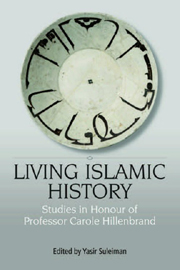Book contents
- Frontmatter
- Contents
- Acknowledgements
- Professor Carole Hillenbrand: List of Publications
- Preface
- 1 The Origin of Key Shi‘ite Thought Patterns in Islamic History
- 2 Additions to The New Islamic Dynasties
- 3 Al-Tha‘alibi's Adab al-muluk, a Local Mirror for Princes
- 4 Religious Identity, Dissimulation and Assimilation: the Ismaili Experience
- 5 Saladin's Pious Foundations in Damascus: Some New Hypotheses
- 6 The Coming of Islam to Bukhara
- 7 A Barmecide Feast: the Downfall of the Barmakids in Popular Imagination
- 8 The History of the Patriarchs of the Egyptian Church as a Source for the History of the Seljuks of Anatolia
- 9 Genealogy and Exemplary Rulership in the Tarikh-i Chingiz Khan
- 10 Vikings and Rus in Arabic Sources
- 11 Qashani and Rashid al-Din on the Seljuqs of Iran
- 12 Exile and Return: Diasporas of the Secular and Sacred Mind
- 13 Clerical Perceptions of Sufi Practices in Late Seventeenth-Century Persia, II: Al-Hurr al-‘Amili (d. 1693) and the Debate on the Permissibility of Ghina
- 14 On Sunni Sectarianism
- 15 The Violence of the Abbasid Revolution
- 16 Nationalist Poetry, Conflict and Meta-linguistic Discourse
- Bibliography
- List of Contributors
- Index
5 - Saladin's Pious Foundations in Damascus: Some New Hypotheses
Published online by Cambridge University Press: 12 September 2012
- Frontmatter
- Contents
- Acknowledgements
- Professor Carole Hillenbrand: List of Publications
- Preface
- 1 The Origin of Key Shi‘ite Thought Patterns in Islamic History
- 2 Additions to The New Islamic Dynasties
- 3 Al-Tha‘alibi's Adab al-muluk, a Local Mirror for Princes
- 4 Religious Identity, Dissimulation and Assimilation: the Ismaili Experience
- 5 Saladin's Pious Foundations in Damascus: Some New Hypotheses
- 6 The Coming of Islam to Bukhara
- 7 A Barmecide Feast: the Downfall of the Barmakids in Popular Imagination
- 8 The History of the Patriarchs of the Egyptian Church as a Source for the History of the Seljuks of Anatolia
- 9 Genealogy and Exemplary Rulership in the Tarikh-i Chingiz Khan
- 10 Vikings and Rus in Arabic Sources
- 11 Qashani and Rashid al-Din on the Seljuqs of Iran
- 12 Exile and Return: Diasporas of the Secular and Sacred Mind
- 13 Clerical Perceptions of Sufi Practices in Late Seventeenth-Century Persia, II: Al-Hurr al-‘Amili (d. 1693) and the Debate on the Permissibility of Ghina
- 14 On Sunni Sectarianism
- 15 The Violence of the Abbasid Revolution
- 16 Nationalist Poetry, Conflict and Meta-linguistic Discourse
- Bibliography
- List of Contributors
- Index
Summary
All his life, Saladin had a particular affection for Damascus. It was there that he spent much of his youth and embarked on his political career under the guidance of his father, his uncle and his master Nur al-Din. It was in that city that he liked to live between military campaigns and finally it was there that he died in 589/1193. As Baha’ al-Din Ibn Shaddad said of him, ‘He loved this city and preferred residence there over all other places’ (Ibn Shaddad 1964: 241, 2001: 237). The Syrian capital in its turn wished to pay tribute to Saladin and to celebrate the decisive role he played in the history of the city, by erecting an imposing statue of the sultan below the walls of the citadel (Hillenbrand 1999: 595-600). Today, his mausoleum, situated to the north of the Umayyad Mosque, still attracts very large numbers of visitors.
The buildings constructed by Saladin in Damascus reflect the principal directions of his political thinking. In the military sphere he strengthened the city's defences with the reconstruction of one of the towers of the citadel in 574/1178 and, in Safar 589/February 1193, he restored the western gate in the ramparts known as Bab al-Jabiya. He also reopened an earlier gate situated to the south of the citadel, renaming it the Gate of Victory (Bab al-Nasr). In the religious sphere the sultan had work done on the Umayyad Mosque where the Dome of the Eagle over the central nave was restored, the marble cladding of some of the pillars was entirely renewed and the Shafi‘ite zawiya inside the mosque was endowed with new waqfs.
- Type
- Chapter
- Information
- Living Islamic HistoryStudies in Honour of Professor Carole Hillenbrand, pp. 62 - 76Publisher: Edinburgh University PressPrint publication year: 2010



